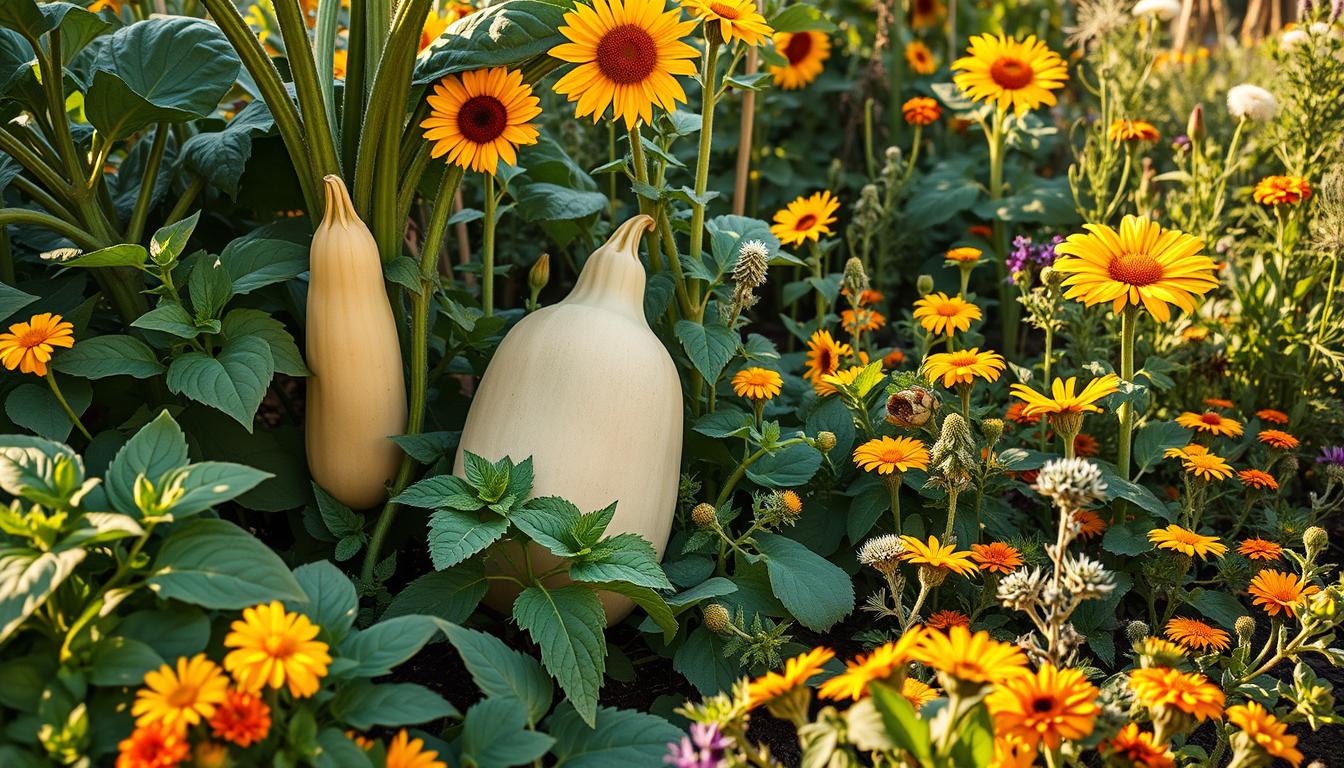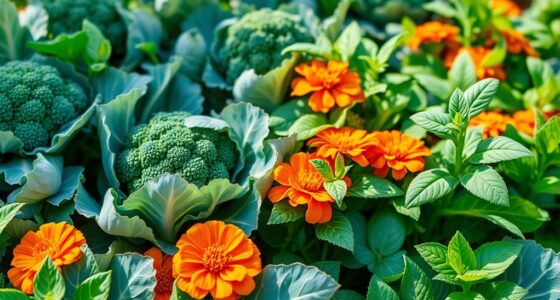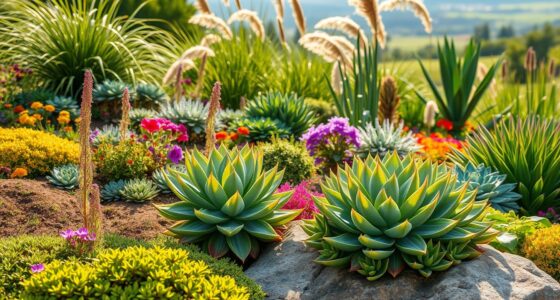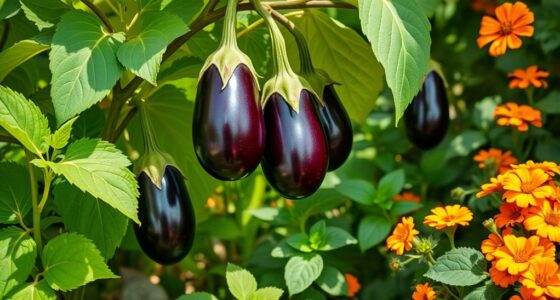Do you remember the excitement of planting a garden, the anticipation of nurturing something from a tiny seed to a thriving vegetable? Squash is often a star performer, but did you know that your squash can thrive even more when paired with the right companions? Exploring the world of squash companion plants can transform your gardening experience, helping you make the most of your space while fostering a flourishing ecosystem in your backyard. Understanding companion planting with squash will not only enhance your garden’s health but also enrich the flavor and yield of your produce. Let’s dive in and discover the best companion plants for squash that can elevate your gardening game.
Key Takeaways
- Companion planting enhances the growth and health of squash.
- Choosing the right plants can maximize your garden’s yield.
- Squash thrives alongside specific plants, boosting flavor and productivity.
- Understanding plant relationships can prevent pests and diseases.
- Fostering a diverse garden contributes to a sustainable ecosystem.
Why Companion Planting Matters for Squash
Companionship in planting, particularly with organic squash companion plants, plays a vital role in creating a flourishing garden. By considering plant relationships, you can significantly enhance growth and overall health within your vegetable plot. This method offers a range of benefits, such as protecting your crops from pests, enriching soil, and optimizing moisture retention.
Benefits of Companion Planting
One of the most notable benefits of companion planting is the natural support it provides to squash plants. When planted alongside complementary species, squash not only thrives but can also yield better flavor and productivity. Enhancing the local ecosystem through diverse plant combinations fosters a vibrant growing environment. Different plants can help each other by repelling pests or attracting beneficial insects, ensuring a balanced ecosystem in your garden.
Pest Control and Prevention
Incorporating organic squash companion plants can significantly contribute to pest control. Certain companion plants deter common squash pests, including aphids and squash bugs, safeguarding your precious crops. By planting strategically, you build a natural barrier against unwanted insects, minimizing the need for chemical pesticides.
Enhancing Soil Health
Companionship in planting allows for enhanced soil health, a critical factor for squash that requires nutrient-rich environments. For instance, legumes like beans, when paired with squash, can naturally increase nitrogen levels in the soil, benefiting heavy feeders. This synergy not only nourishes your squash plants but also promotes a sustainable gardening practice.
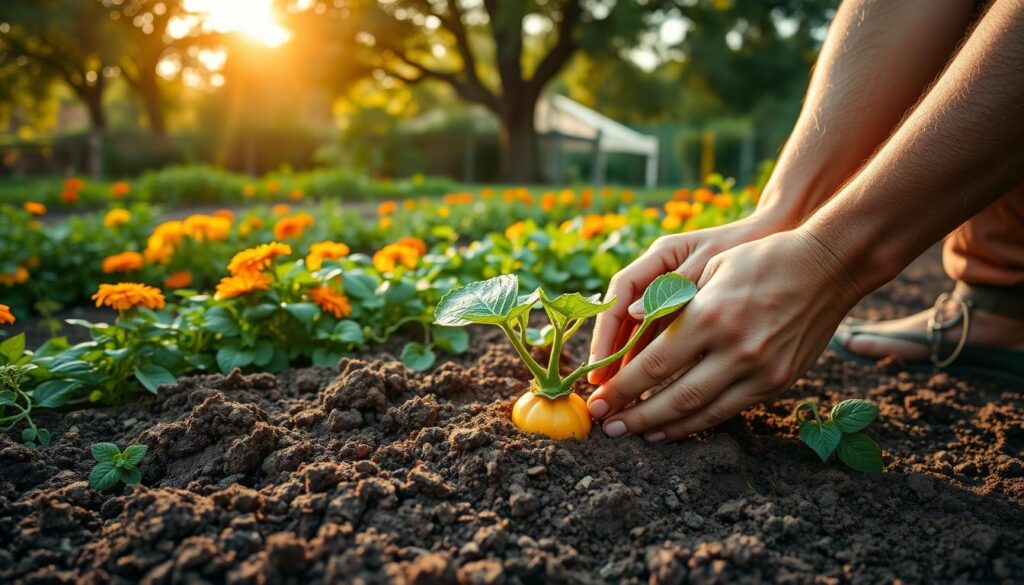
Ideal Squash Companion Plants for Your Garden
Creating a thriving garden involves selecting the right squash plant companions. By pairing squash with specific plants, you can enhance growth while maintaining a healthy garden ecosystem. Here are some ideal companions to consider.
Corn: A Natural Support for Squash
Corn serves as a robust support for your squash plants. As corn grows tall, it offers shade for squash, protecting it from excessive sunlight. This shade reduces weed competition, promoting a healthier growth environment for your squash. The corn squash companion relationship opens the door to a more productive garden.
Beans: Nitrogen Fixation Benefits
Incorporating beans into your squash garden provides significant advantages. Beans, as nitrogen-fixing plants, enrich the soil quality through nitrogen production. This enrichment benefits the squash, promoting healthier plants and better yields. The combination of beans and squash fosters a productive and sustainable gardening experience.
Marigolds: Pest Repellents in Bloom
With vibrant blooms, marigolds make an excellent companion for squash. These flowers attract beneficial insects while repelling harmful pests that threaten squash crops. Pairing marigolds in your garden not only enhances aesthetics but also contributes to a safer and healthier environment for your squash plant companions.
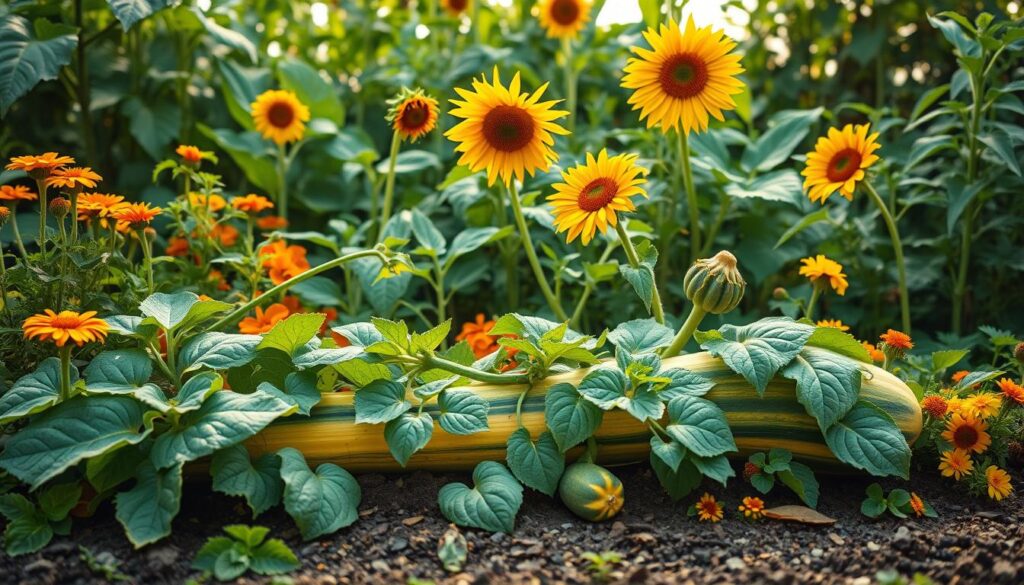
| Companion Plant | Benefits |
|---|---|
| Corn | Provides shade and reduces weed competition. |
| Beans | Fixes nitrogen in the soil, enhancing quality. |
| Marigolds | Repels pests and attracts beneficial insects. |
Vegetables that Pair Well with Squash
Choosing the right vegetables to grow with squash can significantly enhance your garden’s productivity. Certain companion plants can maximize space while helping to deter pests and create a healthy growing environment. Below are some excellent options that complement squash well.
Radishes: Space Savers with Style
Radishes germinate quickly, allowing you to enjoy fast-growing rewards. Acting as trap crops, they draw pests away from squash while utilizing garden space effectively. Their fast life cycle enables you to plant them between rows of squash without fear of overcrowding, making them a smart choice for your garden.
Cucumbers: Sharing Space and Resources
Cucumbers thrive alongside squash, benefiting from similar light and moisture conditions. These vegetables to grow with squash not only share space but also create a vibrant garden atmosphere. Planting cucumbers near squash helps maintain humidity around the plants, potentially enhancing growth and fruit production.
Lettuce: A Cool Companion
Lettuce, being a fast-growing crop, can be sown around squash plants with minimal interference. This cool companion provides shade, which helps regulate the soil temperature and moisture levels. Their shallow roots prevent competition for space, making lettuce an ideal vegetable to grow with squash.
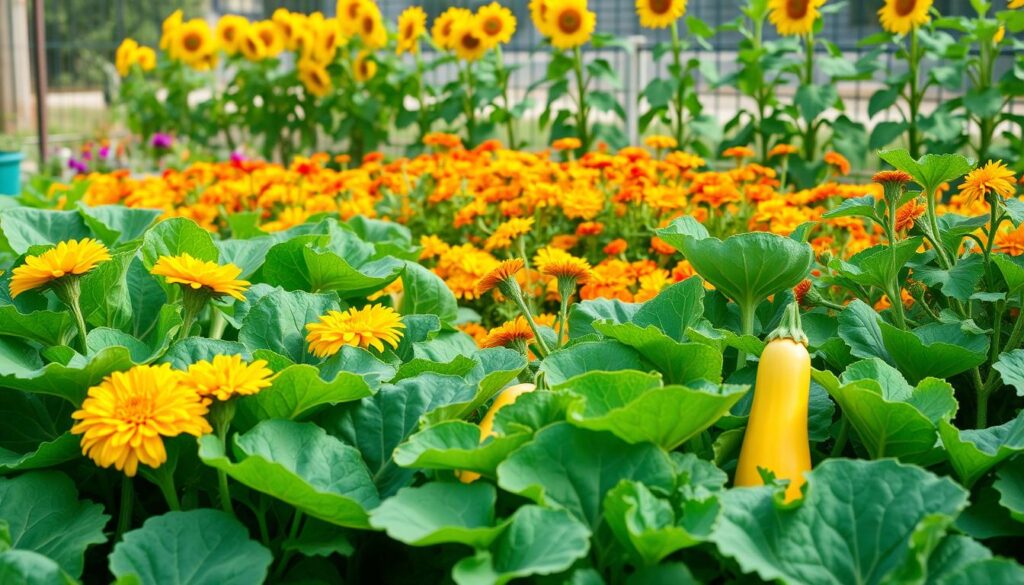
| Companion Vegetable | Benefits | Growth Compatibility |
|---|---|---|
| Radishes | Trap pests, quick germination | Minimal space use |
| Cucumbers | Shared moisture and light needs | Vibrant garden atmosphere |
| Lettuce | Provides shade, fast growth | Shallow roots, minimal competition |
Herbs to Consider Planting with Squash
Incorporating herbs into your garden can enhance your squash growing experience. These beneficial herbs for squash not only improve flavor but also contribute to pest control and invite helpful insects. Here’s a look at some of the top options.
Basil: The Flavorful Companion
Basil stands out as a prime choice among organic squash companion plants. Its aromatic leaves complement squash dishes and help repel common pests such as aphids and spider mites. Grow basil alongside your squash to enjoy the dual benefits of enhanced flavor and natural pest deterrence.
Dill: Attracting Beneficial Insects
Planting dill near squash can create a haven for pollinators and beneficial insects. These creatures support natural pest management, reducing the need for chemical interventions. Dill’s light, feathery foliage provides a striking contrast to squash plants, offering visual appeal while promoting a healthy garden ecosystem.
Oregano: Pest Control and Flavor Boost
Oregano offers a robust flavor that can elevate numerous dishes, particularly those featuring squash. Beyond its culinary uses, the potent aroma of oregano serves as a natural pest repellent. By adding oregano to your garden, you create a space filled with diverse flavors and effective pest control.
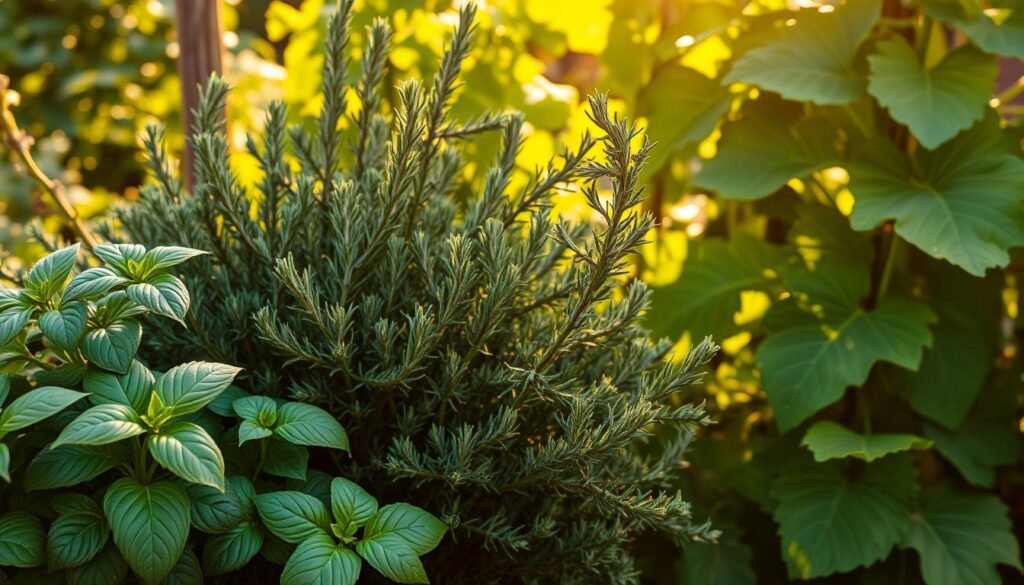
Flowers That Pair Well with Squash
Incorporating flowers into your garden can create a visually stunning environment while enhancing the benefits of companion planting with squash. Flowering plant companions for squash can provide pest control, attract beneficial insects, and improve the growth conditions of your squash plants. Explore some fantastic flowering options that thrive alongside squash plants.
Nasturtiums: Bright Flowers and Pest Deterrents
Nasturtiums bring vibrant colors to your garden while acting as an effective natural pest deterrent. These beautiful flowers repel aphids and other harmful pests that affect squash, making them a perfect choice for companion planting with squash. Their edible flowers and leaves offer a peppery flavor, adding a delightful twist to salads.
Borage: Attracting Pollinators
Borage is an excellent flowering companion that attracts pollinators like bees, enhancing pollination rates for your squash. This hardy herb features star-shaped blue flowers, adding a touch of beauty to your garden. The presence of borage can significantly improve the fruit yield of squash plants, making it an invaluable ally.
Sunflowers: Towering Helpers
Sunflowers stand tall and serve as natural support for climbing varieties of squash. They can provide shade, helping to regulate temperature and moisture levels around your squash plants. This flowering plant not only offers a striking focal point in your garden but also contributes to overall garden biodiversity.
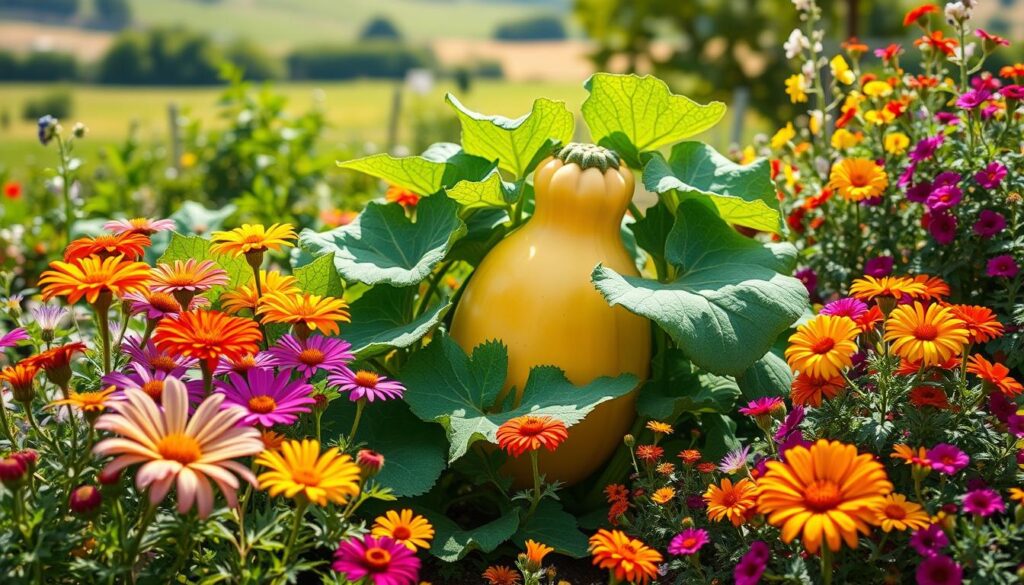
| Flowering Plant | Pest Control | Benefits |
|---|---|---|
| Nasturtiums | Repels aphids | Edible flowers and leaves |
| Borage | Attracts bees | Increases pollination rates |
| Sunflowers | Provides shade | Supports biodiversity |
Avoiding Bad Companions for Squash
When cultivating a successful squash garden, understanding the relationships between various plants is essential. Certain vegetables and herbs can inhibit the growth of squash, leading to underwhelming results. Identifying bad companions for squash helps you make informed choices, ensuring that your garden flourishes. Below are some key groups to consider as you plan your squash plantings.
Vegetables to Keep Away
Some vegetables hinder squash growth by competing for space and nutrients. Here are some plants to avoid with squash:
- Potatoes: They thrive in similar conditions and often share vulnerable pests.
- Tomatoes: Prone to diseases that may crossover to squash.
- Cucumbers: While some may think they pair well, they can harbor pests that affect squash.
Herbal Enemies: What to Avoid
Herbs can either enhance or disrupt the growth of squash. Certain herbs, when planted too close, can alter flavor profiles or create competition. Consider avoiding:
- Mint: Its aggressive growth can overpower squash plants.
- Sage: Can affect the flavor of squash if too close.
- Lavender: Pursuing its own needs, it may negatively impact squash growth.
Understanding Plant Relationships
A comprehensive understanding of plant relationships is vital for a thriving garden. Bad companions for squash not only hinder growth but can also attract pests or diseases. By being mindful of the plants you coexist with, you can create a healthier ecosystem. Proper planning ensures that your squash garden thrives with the right companions.
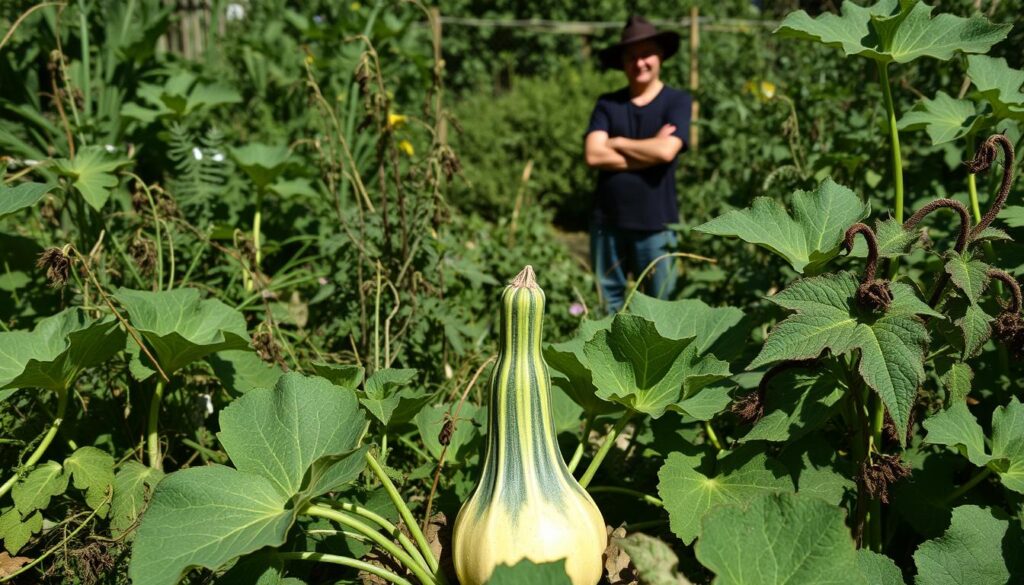
Planting Tips for Success with Squash
Getting your squash off to a great start requires attention to several key factors. You want to ensure optimal garden placement for squash, use proper soil preparation, and time your planting perfectly. These squash planting tips will help you cultivate a thriving squash garden.
Selecting the Right Spot in Your Garden
Your squash plants thrive best in a sunny area that receives at least six hours of direct sunlight each day. When choosing the garden placement for squash, keep in mind that they need space to grow. Their sprawling vines require adequate room to spread without crowding other plants. Select a location that provides enough sunlight and space while considering factors like air circulation and proximity to water.
Proper Soil Preparation
Before planting, soil preparation plays a crucial role in your squash’s success. Start by testing your soil’s pH and nutrient levels. Squash prefers a pH between 6.0 and 7.0. Enrich your soil with plenty of organic matter, such as compost or well-rotted manure, to enhance drainage and fertility. This will establish a healthy foundation for vigorous growth and support both squash and its companion plants.
Timing for Planting Companion Plants
Timing is vital when it comes to introducing companion plants. It’s essential to plant them at the right stages of growth to maximize benefits such as pest control and improved soil health. Begin by sowing squash seeds after the last frost date for your area. Integrate companion plants around the same time or shortly thereafter to ensure they grow together harmoniously and provide their helpful traits when they are needed most.
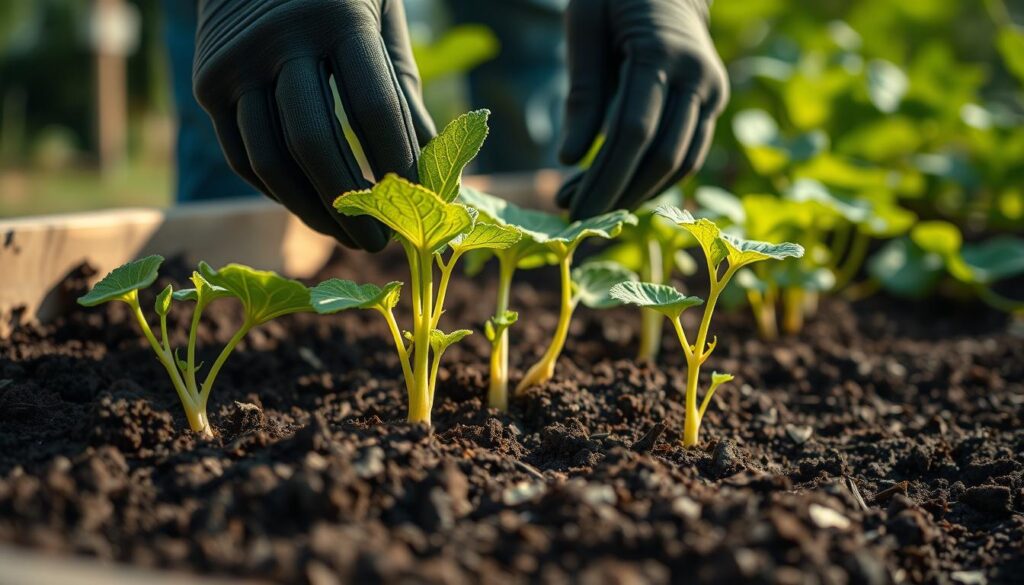
| Aspect | Details |
|---|---|
| Sunlight | 6+ hours of direct sunlight |
| Soil Type | Well-draining, rich in organic matter |
| pH Level | 6.0 to 7.0 |
| Companion Timing | Plant with squash or shortly after |
How to Care for Squash and Their Companions
Effective care for your squash and its companions plays a pivotal role in the overall success of your garden. A solid understanding of watering techniques, intentional fertilization, and diligent pest monitoring establishes a thriving ecosystem. Implementing these organic care tips for squash companions will lead to a plentiful harvest.
Watering Needs and Strategies
Regular watering is crucial for squash, particularly as they require consistent moisture to thrive. As a rule of thumb, aim to provide about 1 to 2 inches of water weekly. Watering early in the morning reduces evaporation and allows the plants to absorb moisture effectively. Consider using mulch to retain soil moisture and prevent weeds from overtaking your garden.
Fertilizing with Purpose
When fertilizing, prioritize a nitrogen-rich organic fertilizer to support both squash and its companion plants. Applying fertilizer at planting time and again midway through the growing season helps ensure nutrient availability. Always follow package instructions to avoid overwhelming your plants with excessive nutrients.
Monitoring for Pests and Issues
Diligently monitoring for pests keeps your garden healthy. Regularly inspect leaves and stems for signs of pests like aphids or squash bugs. Introducing beneficial insects, such as ladybugs, can help protect your plants. Using companion planting techniques can provide a natural barrier against pests while promoting a balanced ecosystem.
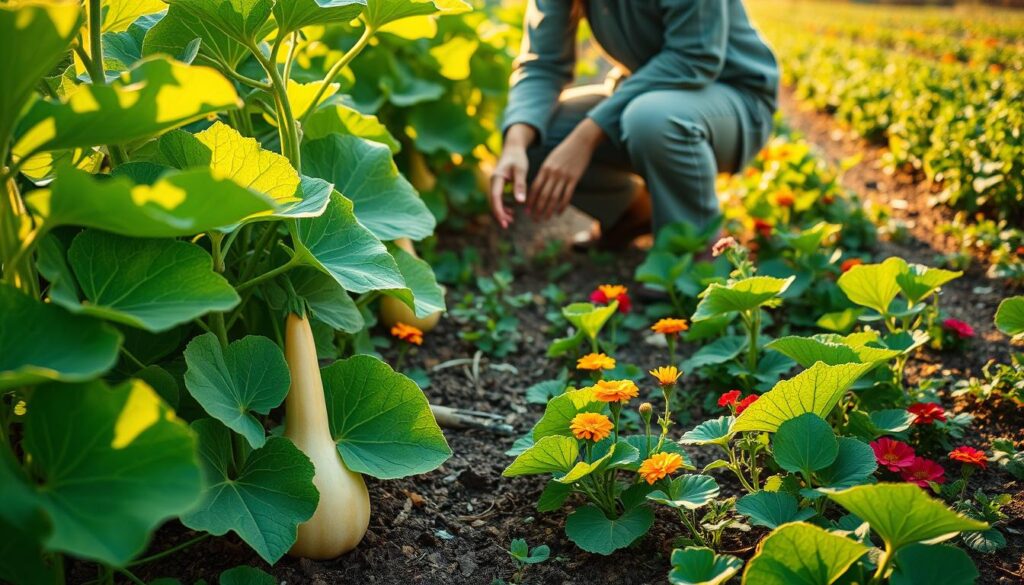
Seasonal Considerations for Squash Companion Planting
Understanding the seasonal cycles is crucial for successful squash companion planting. Each stage of the growing season plays a distinct role in ensuring your plants thrive while benefiting from their companions. By following seasonal tips for squash planting, you can maximize yields and maintain healthy garden dynamics.
Spring Planting: Preparing for Growth
In spring, temperatures begin to rise, making it the ideal time for planting both squash and its companions. Focus on selecting robust varieties suited for your climate. Make sure to prepare the soil adequately by incorporating organic matter, which enhances nutrient availability. This sets a strong foundation for year-round squash care as these plants begin to grow actively.
Summer Maintenance: Keeping Plants Healthy
As summer heat intensifies, you must pay close attention to the health of your squash and companion plants. Regular watering is essential, particularly during dry spells. Implement mulch to retain moisture and control weeds. Be vigilant in monitoring pest activity, as the warm weather can attract unwanted insects. These practices ensure your garden remains productive during peak growth periods.
Fall Care: Preparing for Harvest
With fall approaching, it’s a critical time for managing your squash plants. As harvesting begins, evaluate the health of your remaining plants and consider crop rotation strategies. This practice enriches soil health, preparing it for the next planting season. Gathering fallen leaves and other organic materials can be used to create compost, supporting year-round squash care. Embrace this opportunity to nurture the soil and enrich your garden ecosystem.
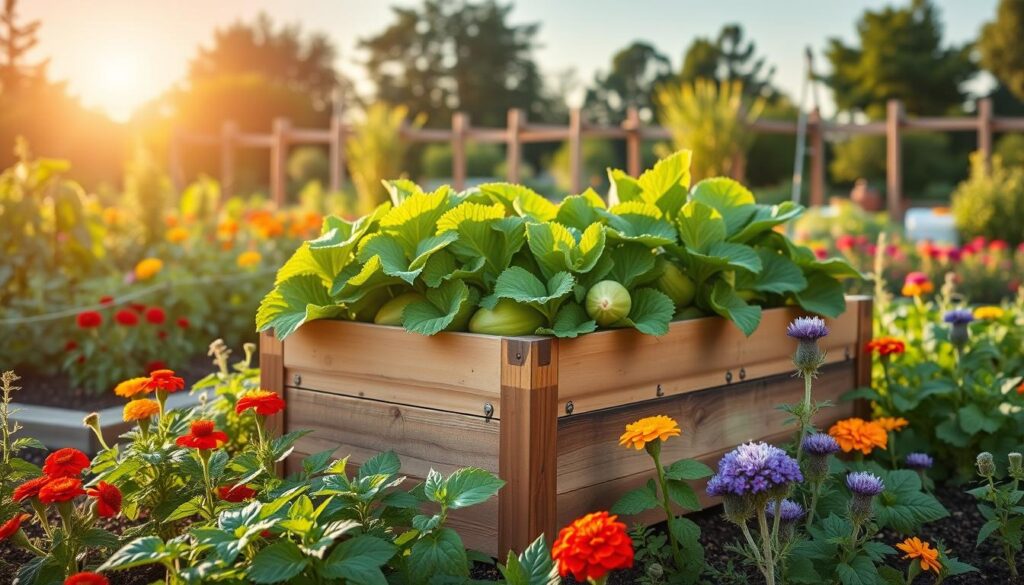
Common Mistakes in Squash Companion Planting
When engaging in squash companion planting, it’s easy to make mistakes that can hinder your garden’s success. Recognizing these errors is key to optimizing your growing experience. Here are some critical missteps that gardeners frequently make.
Ignoring Plant Needs and Compatibility
Each plant species has specific needs regarding sunlight, water, and nutrients. Ignoring these requirements can lead to poor growth and even plant failure. Understanding compatibility is essential. Some plants are natural allies, while others may compete for resources or harbor pests.
Overcrowding: Spacing Your Plants
One of the most common mistakes to avoid in squash planting involves planting too closely together. Overcrowding can lead to increased competition for nutrients and reduce air circulation. This creates an environment conducive to disease development and pest infestations. Ensuring adequate spacing allows each plant to thrive.
Neglecting Soil Quality
Healthy soil is foundational for a flourishing garden. Neglecting soil quality can lead to nutrient deficiencies and stunted growth. Regularly testing and amending your soil ensures that all plants in your garden receive what they need to flourish. Investing in rich, balanced soil is vital for successful squash companion planting.
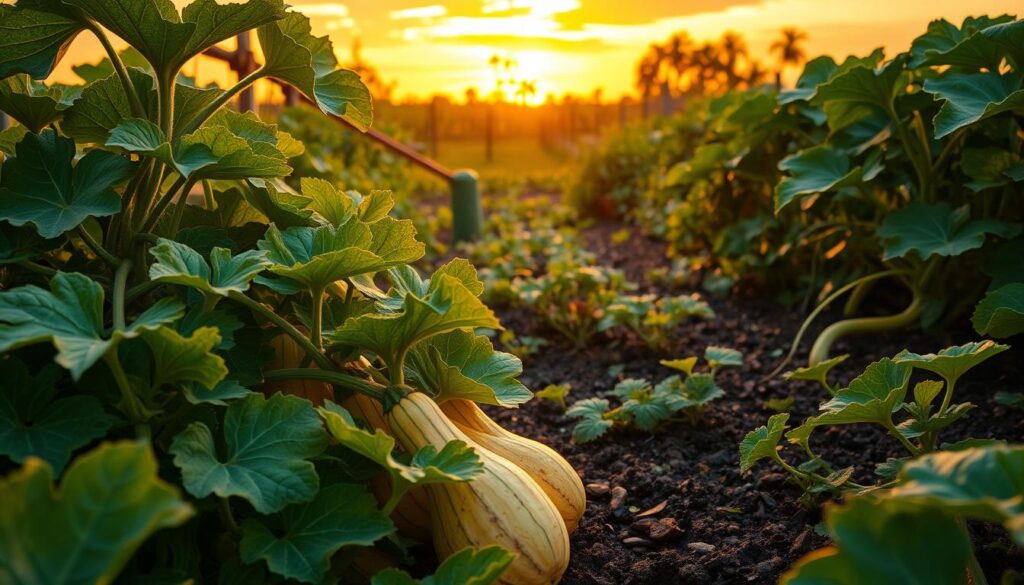
Harvesting: Timing and Techniques
Understanding when and how to harvest squash can significantly impact your gardening success. Knowing the ideal time for harvesting squash and employing proper techniques ensures you obtain the best quality produce while also supporting your future crop yields.
Identifying the Right Time to Harvest
The right time to harvest squash usually depends on the variety being grown. Generally, you should pick squash when they are firm, fully grown, and exhibit their characteristic color. If you detect any signs of overripening, such as overly hard skin or dull color, it’s better to harvest sooner rather than later. Keeping an eye on your plants will aid in precisely timing your harvesting efforts.
Proper Techniques for Picking Squash
Employing the right harvesting squash techniques is crucial for minimizing damage to both the squash and the plant. Use a sharp knife or pruning shears to cut the stem about one inch above the fruit. Avoid twisting or pulling the squash, as this can harm the plant and future growth. Be gentle in your approach to ensure the longevity of your plants.
Storing Your Harvest Effectively
After harvesting, employing effective storage tips for squash is key to preserving their quality. Store your squash in a cool, dry place with good ventilation. This helps prevent moisture buildup that can lead to spoilage. Avoid placing squash in direct sunlight or in the refrigerator, as these conditions can negatively affect their flavor and texture.
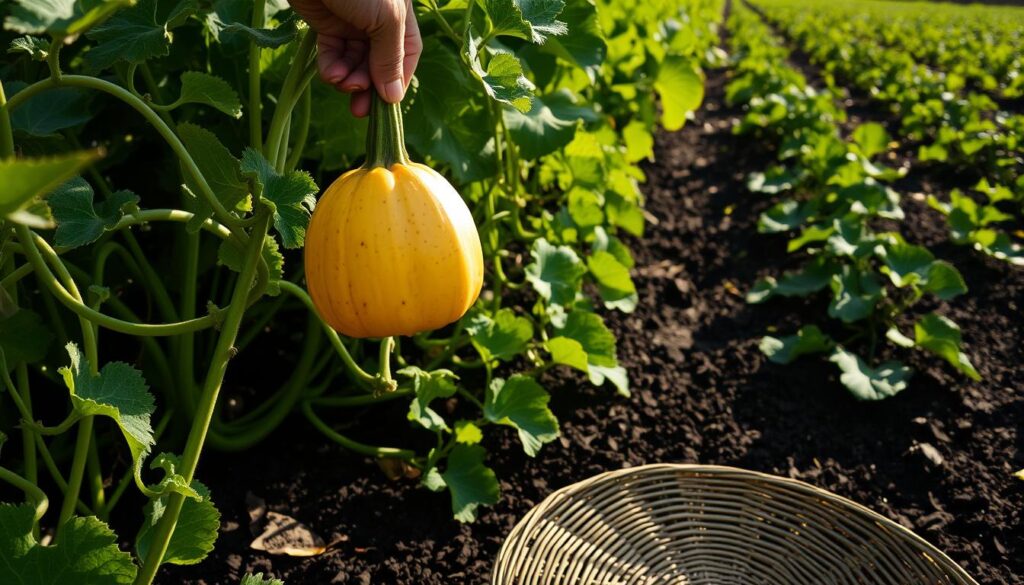
| Type of Squash | Harvest Time Indicators | Storage Recommendations |
|---|---|---|
| Zucchini | Fruits are 6-8 inches long and firm | Store in a cool, dry area |
| Butternut | Color changes to beige/yellow and hard skin | Keep in a dark, dry place |
| Acorn | Skin is hard and color changes to dark green | Store in a cool pantry |
| Spaghetti | Fully grown, hard outer shell | Store in a dry, room temperature location |
Recipes Featuring Fresh Squash and Companion Plants
Cooking with squash opens the door to a world of vibrant flavors and nutritious meals. By utilizing squash and its companion plants, you can create delightful dishes that showcase the best of your garden’s bounty. Here are some creative ideas that combine squash with fresh herbs and other vegetables.
Delicious Squash Salad Ideas
Salads with fresh squash provide a colorful and refreshing dish. Combine sliced zucchini and yellow squash with cherry tomatoes, cucumbers, and a handful of arugula for a crunchy base. Drizzle with a tangy vinaigrette made from olive oil, balsamic vinegar, and a hint of mustard. You can enhance the flavor by adding basil and mint, two excellent recipes for squash companions.
Using Fresh Herbs in Your Cooking
Incorporate fresh herbs such as thyme and oregano into your cooking with squash. A simple roasted squash medley can include diced butternut squash, rosemary, and garlic. Toss everything in olive oil, season with salt and pepper, and roast until golden brown. This method not only emphasizes the natural sweetness of the squash but also complements the herbs beautifully.
Incorporating Other Companion Veggies
Don’t shy away from mixing in other companion veggies. Pairing cooked spaghetti squash with sautéed kale, onions, and bell peppers creates a hearty and healthful dish. Top it off with grated Parmesan cheese for an added layer of flavor. Remember, recipes for squash companions are limitless when you let your creativity lead the way.
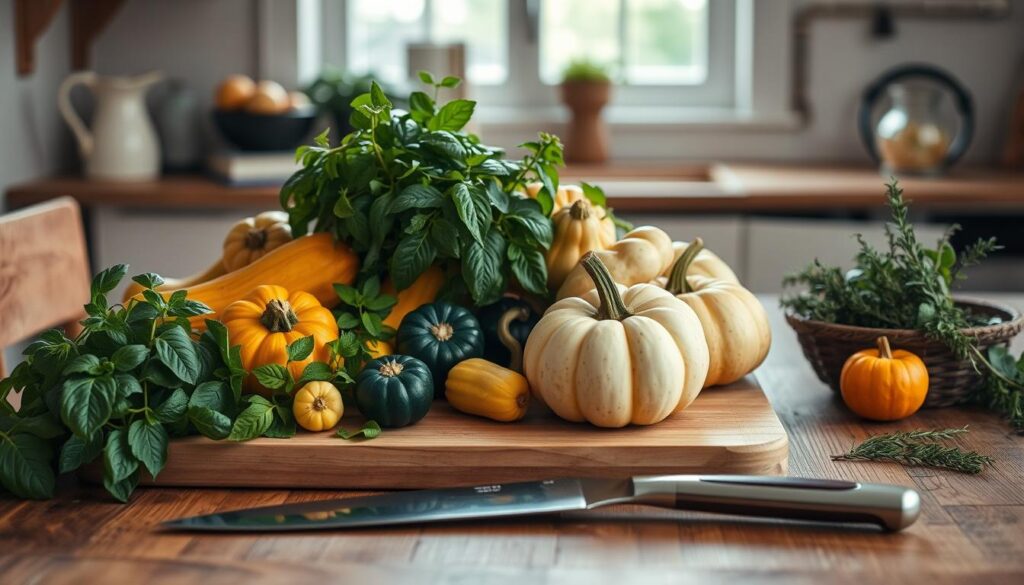
Pest Management Strategies for Squash
Effective pest management for squash is essential for ensuring a healthy, productive garden. Recognizing common pests and employing natural, organic pest control methods can make a significant difference in your squash harvest. Understanding these strategies will help you create a balanced ecosystem that encourages beneficial insects while keeping harmful pests at bay.
Identifying Common Pests
Squash plants often face threats from pests like squash bugs and cucumber beetles. These pests can cause extensive damage, leading to stunted growth or even plant death. Regularly inspect your plants for signs of infestation, such as yellowing leaves, wilting, or visible insects. Early detection is vital for effective pest management for squash.
Natural Remedies for Pest Control
Utilizing organic pest control methods can mitigate pest issues without harming beneficial insects. Some effective strategies include:
- Introducing beneficial insects like ladybugs and lacewings, which prey on squash pests.
- Applying neem oil or insecticidal soap to target specific pests.
- Using diatomaceous earth as a barrier, which can deter insects without causing harm to your plants.
How Companion Plants Help
Companion plants play a crucial role in pest management for squash. Certain plants can repel harmful insects or attract predators, creating a natural balance. For instance, marigolds help deter nematodes and attract beneficial insects, while borage can increase the resilience of nearby plants. Planting these companions alongside your squash not only enhances your garden’s diversity but also aids in organic pest control methods.
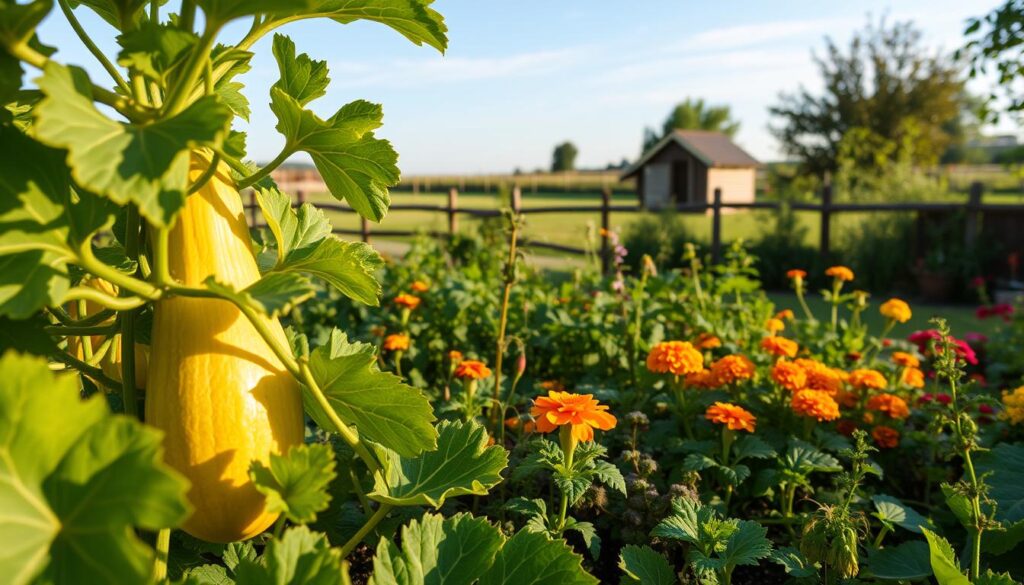
Implementing these pest management strategies will promote a thriving garden environment, allowing your squash and companion plants to flourish together. With consistent observation and organic practices, you can enjoy a healthy crop and minimize pest-related challenges.
Nutritional Benefits of Squash and Their Companions
Squash presents a wealth of health benefits, making it a favorite among gardeners and health enthusiasts alike. Rich in vitamins A and C, fiber, and antioxidants, squash contributes positively to a balanced diet. When you plant squash alongside other vegetables, you can unlock even greater potential for nutritional value. Utilizing companion plants enhances the overall diet and introduces a colorful array of flavors and nutrients.
Health Benefits of Squash
Incorporating squash into your meals can boost overall well-being. The health benefits of squash include:
- Improved digestion thanks to high fiber content.
- Enhanced immune function from vitamins A and C.
- Antioxidant properties that may reduce inflammation.
Nutritional Value of Companion Veggies
Companion vegetables play a crucial role in the nutritional content of companion plants. For example:
| Companion Plant | Nutritional Highlights |
|---|---|
| Beans | Rich in protein and fiber; aid nitrogen fixation in the soil. |
| Basil | Contains antioxidants and essential oils that promote health. |
| Cucumbers | High water content and low calories make them refreshing. |
How to Maximize Your Garden’s Nutrition
To truly harness the health benefits of squash and maximize your garden’s nutrition, consider these strategies:
- Choose a variety of companion plants that diversify nutrients.
- Rotate your crops yearly to maintain soil health.
- Incorporate organic matter, like compost, to enrich the soil further.
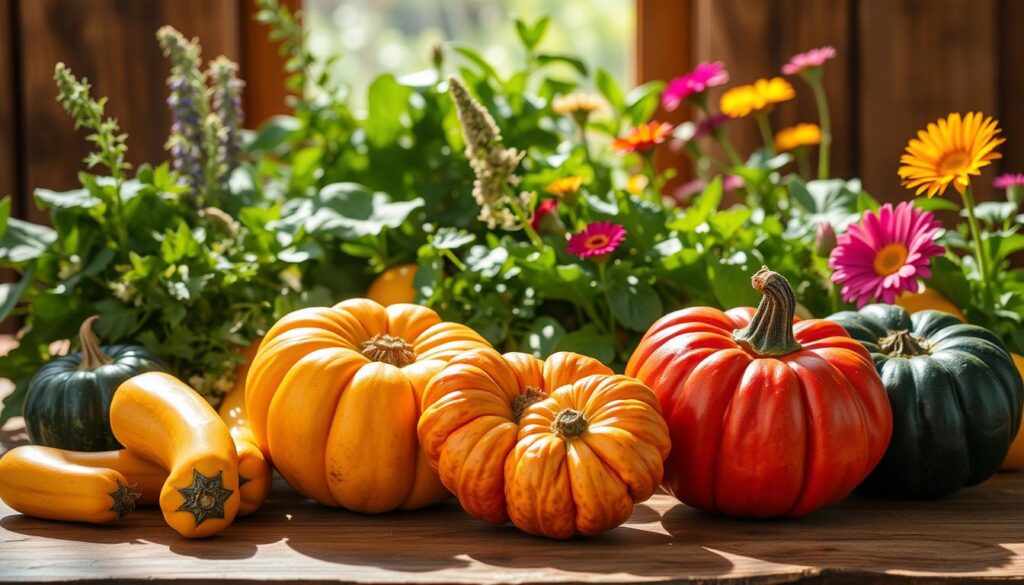
Encouraging a Biodiverse Garden with Squash
Creating a garden that embraces biodiversity is essential for long-term sustainability and resilience. Integrating squash into your gardening practices fosters sustainable ecosystems with squash. This approach promotes healthier plants and encourages beneficial wildlife.
Attracting Pollinators and Helpful Insects
Pollinators like bees and butterflies play a critical role in your garden’s health. They contribute significantly to the productivity of squash by aiding in pollination. Planting companion flowers alongside your squash can attract these helpful insects, ensuring that your plants thrive.
Importance of Plant Diversity
Incorporating a variety of plant species creates a balanced ecosystem. The diversity enhances the overall health of your garden and increases resilience against pests and diseases. When you prioritize biodiversity in gardening, you support a wider array of beneficial insects and other wildlife that contribute to a robust environment.
Building a Sustainable Ecosystem
Establishing a sustainable ecosystem with squash requires careful planning and management of your garden. By mixing different plants, you foster a habitat that supports various life forms. This not only benefits your squash but also enriches the entire garden environment. Embracing such practices promotes biodiversity, which in turn contributes to a flourishing garden.
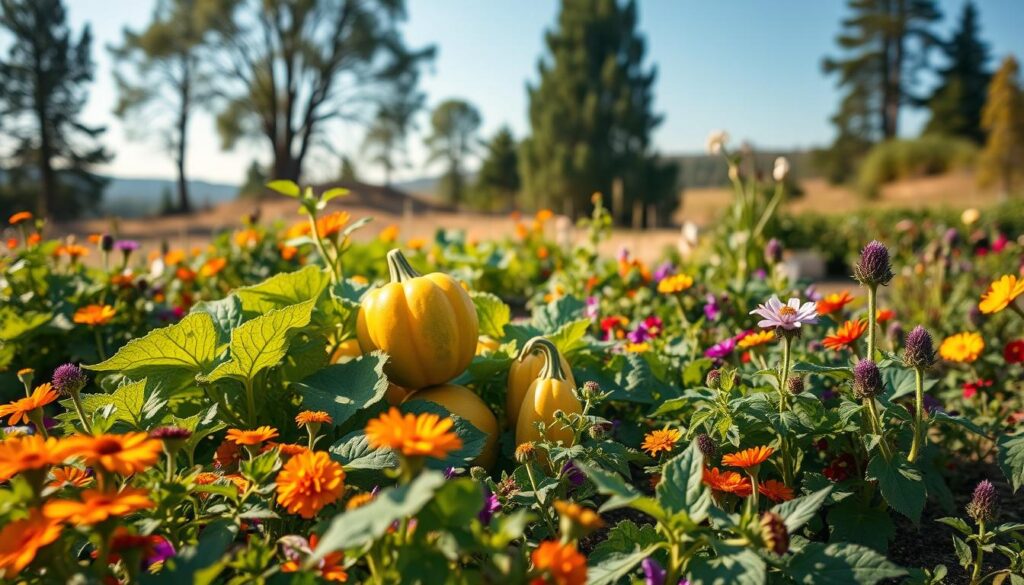
| Attribute | Importance |
|---|---|
| Pollinators | Enhance squash productivity through effective pollination |
| Plant Diversity | Increases resilience against pests and diseases |
| Beneficial Insects | Support natural pest control and ecosystem balance |
| Companion Plants | Provide nutrients and help attract helpful wildlife |
Conclusion: Creating a Thriving Squash Garden
As you wrap up your journey of planting and nurturing a thriving squash garden, it’s essential to reflect on the advantages of companion planting and the choices you’ve made along the way. By selecting compatible plants, you not only enhance the vitality of your squash but also create a balanced ecosystem that can fend off pests and improve soil health. These beneficial relationships contribute significantly to the overall success of your garden.
On your path toward a successful harvest, remember that every choice you make—from soil preparation to pest management—plays a crucial role in the growth of your squash. Engage with seasonality and keep an eye on the needs of your companion plants. Your attentiveness will ensure that your garden not only yields delicious squash but also provides a rich and inviting habitat for beneficial insects and pollinators.
Finally, keep these tips for successful squash planting close at hand: focus on diverse planting, monitor the health of your plants, and enrich your soil regularly. By combining these strategies, you can unlock the full potential of your thriving squash garden, making the experience not just fruitful but also enjoyable and fulfilling.
